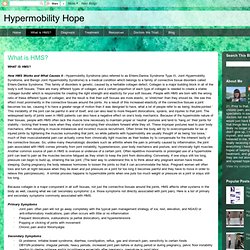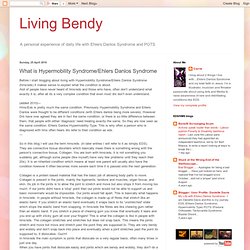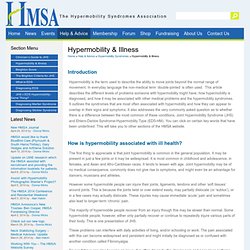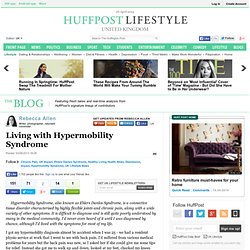

Hypermobility Hope: What is HMS? How HMS Works and What Causes it - Hypermobility Syndrome (also referred to as Ehlers-Danlos Syndrome Type III, Joint Hypermobility Syndrome, and Benign Joint Hypermobility Syndrome) is a medical condition which belongs to a family of connective tissue disorders called Ehlers-Danlos Syndrome.

This family of disorders is genetic, caused by a heritable collagen defect. Collagen is a major building block in all of the body’s soft tissues. There are many different types of collagen, and a certain proportion of each type of collagen is needed to create a stable ‘collagen bundle’ which is responsible for creating the right strength and elasticity for your soft tissues. People with HMS are born with the wrong ratio of these different types of collagen, and the result is that their soft tissues are more elastic, or ‘stretchier’ than they should be. We see this effect most prominently in the connective tissues around the joints. Primary Symptoms.
EDHS.info. Syndromes Association » How come so many adults with Ehlers-Danlos syndromes,... How come so many adults with Ehlers-Danlos syndromes, or the wider umbrella term Hypermobility syndromes (HMS), are accused of having a ‘fabricated’ or ‘factitious illnesses’ or ‘Munchausen’s’?

This article is not supposed to give all the answers but to encourage the discussion of what appears to be the over-diagnosing and accusations towards EDS adult sufferers (or HMS adult patients in general) of having a ‘fabricated illness’. It does not address the accusations that parents may be making up illness in children or making their children’s recognised condition worse. It does not look at the role of psychosomatic symptoms. This is purely thoughts on adults and the disorders. Living Bendy: What is Hypermobility Syndrome/Ehlers Danlos Syndrome.
Before I start blogging about living with Hypermobility Syndrome/Ehlers Danlos Syndrome (hms/eds) it makes sense to explain what the condition is about.Alot of people have never heard of hms/eds and those who have, often don't understand what exactly it is, after all its a very complex condition that even most drs don't even understand.

(added 2010)---Hms/Eds is pretty much the same condition. Previously Hypermobility Syndrome and Ehlers Danlos were thought to be different conditions (with Ehlers danlos being more severe). However Drs have now agreed they are in fact the same condition, or there is so little difference between them, that people with either 'diagnosis' need treating exactly the same. So they are now seen as the same condition.
Ehlers Danlos:Hypermobility Type. So in this blog I will use the term hms/eds. Collagen is a protein based material that has the basic job of allowing body parts to move. Hms/Eds varies massivley in severity. Syndromes Association » Hypermobility & Illness. Introduction Hypermobility is the term used to describe the ability to move joints beyond the normal range of movement.

In everyday language the non-medical term ‘double-jointed’ is often used. But You Dont Look Sick? support for those with invisible illness or chronic illness. Please take the time to read Christine Miserandino’s personal story and analogy of what it is like to live with sickness or disability. by Christine Miserandino www.butyoudontlooksick.com My best friend and I were in the diner, talking.

As usual, it was very late and we were eating French fries with gravy. Like normal girls our age, we spent a lot of time in the diner while in college, and most of the time we spent talking about boys, music or trivial things, that seemed very important at the time. We never got serious about anything in particular and spent most of our time laughing. As I went to take some of my medicine with a snack as I usually did, she watched me with an awkward kind of stare, instead of continuing the conversation. I started to ramble on about pills, and aches and pains, but she kept pursuing, and didn’t seem satisfied with my answers.
As I tried to gain my composure, I glanced around the table for help or guidance, or at least stall for time to think. Rebecca Allen: Living with Hypermobility Syndrome. Hypermobility Syndrome, also known as Ehlers Danlos Syndrome, is a connective tissue disorder characterised by highly flexible joints and chronic pain, along with a wide variety of other symptoms.

It is difficult to diagnose and is still quite poorly understood by many in the medical community. I'd never even heard of it until I was diagnosed by chance, although I'd lived with the symptoms for most of my life. I got my hypermobility diagnosis almost by accident when I was 25 - we had a resident physio service at work that I went to see with back pain.
I'd suffered from various medical problems for years but the back pain was new, so I asked her if she could give me some tips for relief. Instead she got me to walk up and down, looked at my feet, checked my knees and wrists, got me to bend my fingers back and asked if I had asthma, IBS, anxiety and if I had a lot of accidents. 'I feel brain-fogged. It’s a cruelly deceptive illness’ Joint hypermobility. Joint hypermobility. Joint hypermobility means some or all of a person's joints have an unusually large range of movement.

People with hypermobility are particularly supple and able to move their limbs into positions others find impossible. Many people with hypermobile joints do not have any problems or need treatment. However, joint hypermobility can sometimes cause unpleasant symptoms, such as: joint pain back pain dislocated joints – when the joint comes out if its correct position soft tissue injuries, such as tenosynovitis (inflammation of the protective sheath around a tendon) Hypermobility Syndromes Association. Time to take hypermobility seriously (in adults and children)